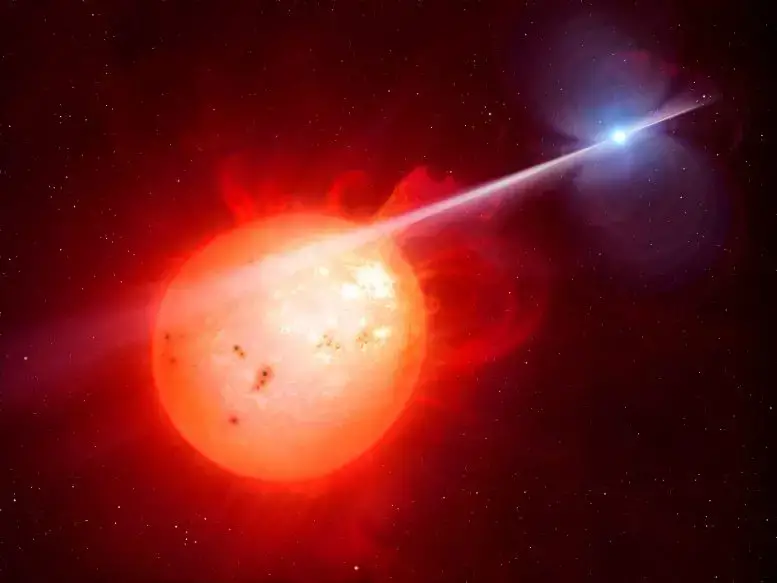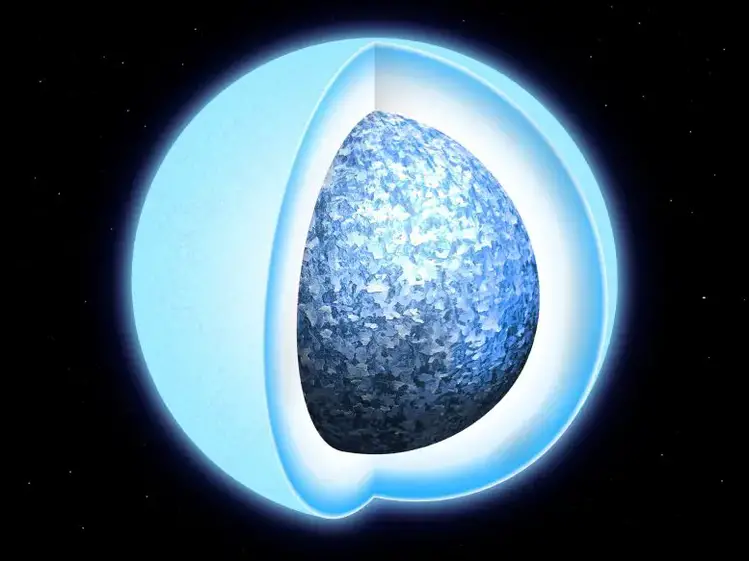A research team has made the second-ever discovery of a rare type of white dwarf pulsar system, a significant advancement in understanding stellar evolution. The pulsar, identified as J1912-4410, spins rapidly, sending out intense beams of electrical particles and radiation at regular intervals, caused by its potent magnetic fields. Scientists theorize these fields might originate from an internal dynamo, akin to Earth’s, but far more powerful. Credit: Dr. Mark Garlick//University of Warwick
 A research group from the University of Warwick has discovered a rare white dwarf pulsar for only the second time, providing significant insights into stellar evolution. The pulsar’s strong magnetic fields, rapid spinning, and cool temperature support the dynamo model theory and signify the star’s advanced age, further validating the existence of more such systems.
A research group from the University of Warwick has discovered a rare white dwarf pulsar for only the second time, providing significant insights into stellar evolution. The pulsar’s strong magnetic fields, rapid spinning, and cool temperature support the dynamo model theory and signify the star’s advanced age, further validating the existence of more such systems.
The discovery of a rare type of white dwarf star system provides new understanding into stellar evolution.
White dwarfs are small, dense stars typically the size of a planet. They are formed when a star of low mass has burnt all its fuel, losing its outer layers. Sometimes referred to as “stellar fossils,” they offer insight into different aspects of star formation and evolution.
A rare type of white dwarf pulsar has been discovered for the second time only, in research led by the University of Warwick. White dwarf pulsars include a rapidly spinning, burnt-out stellar remnant called a white dwarf, which lashes its neighbor – a red dwarf – with powerful beams of electrical particles and radiation, causing the entire system to brighten and fade dramatically over regular intervals. This is owing to strong magnetic fields, but scientists are unsure what causes them.
A key theory that explains the strong magnetic fields is the “dynamo model” – that white dwarfs have dynamos (electrical generators) in their core, as does the Earth, but much more powerful. But for this theory to be tested, scientists needed to search for other white dwarf pulsars to see if their predictions held true.

Illustration of a white dwarf, the dead remnant of a star like our Sun, with a crystallized, solid core. Credit: University of Warwick/Mark Garlick
Published on June 15 in Nature Astronomy, scientists funded by the UK Science and Technology Facilities Council (STFC) describe the newly detected white dwarf pulsar, J191213.72-441045.1 (J1912-4410 for short). It is only the second time such a star system has been found, following the discovery of AR Scorpii (AR Sco) in 2016.
773 light years away from Earth and spinning 300 times faster than our planet, the white dwarf pulsar has a size similar to the Earth, but a mass at least as large as the Sun. This means that a teaspoon of white dwarf material would weigh around 15 tons. White dwarfs begin their lives at extremely hot temperatures before cooling down over billions of years, and the low temperature of J1912−4410 points to an advanced age.
Dr. Ingrid Pelisoli, University of Warwick’s Department of Physics, said: “The origin of magnetic fields is a big open question in many fields of astronomy, and this is particularly true for white dwarf stars. The magnetic fields in white dwarfs can be more than a million times stronger than the magnetic field of the Sun, and the dynamo model helps to explain why. The discovery of J1912−4410 provided a critical step forward in this field.
“We used data from a few different surveys to find candidates, focusing on systems that had similar characteristics to AR Sco. We followed up any candidates with ULTRACAM, which detects the very fast light variations expected of white dwarf pulsars. After observing a couple of dozen candidates, we found one that showed very similar light variations to AR Sco. Our follow-up campaign with other telescopes revealed that every five minutes or so, this system sent a radio and X-ray signal in our direction.
“This confirmed that there are more white dwarf pulsars out there, as predicted by previous models. There were other predictions made by the dynamo model, which were confirmed by the discovery of J1912−4410. Due to their old age, the white dwarfs in the pulsar system should be cool. Their companions should be close enough that the gravitational pull of the white dwarf was in the past strong enough to capture mass from the companion, and this causes them to be fast spinning. All of those predictions hold for the new pulsar found: the white dwarf is cooler than 13,000K, spins on its axis once every five minutes, and the gravitational pull of the white dwarf has a strong effect in the companion.
“This research is an excellent demonstration that science works – we can make predictions and put them to test, and that is how any science progresses.”
Dr. Pelisoli is one of the first group of research fellows and PhD students supported by a £3.5 million private philanthropic donation from a Warwick alumnus. One of the largest gifts towards the study of astronomy and astrophysics in the UK, the donation is enabling the next generation of astronomers to explore the furthest reaches of our universe.
Axel Schwope, Leibniz Institute for Astrophysics Potsdam (AIP), who is leading a complementary study published as a letter in Astronomy and Astrophysics, added: “We are excited to have independently found the object in the X-ray all-sky survey performed with SRG/eROSITA. The follow-up investigation with the ESA satellite XMM-Newton revealed the pulsations in the high-energy X-ray regime, thus confirming the unusual nature of the new object and firmly establishing the white dwarf pulsars as a new class.”
Reference: “A 5.3-min-period pulsing white dwarf in a binary detected from radio to X-rays” by Ingrid Pelisoli, T. R. Marsh, David A. H. Buckley, I. Heywood, Stephen. B. Potter, Axel Schwope, Jaco Brink, Annie Standke, P. A. Woudt, S. G. Parsons, M. J. Green, S. O. Kepler, James Munday, A. D. Romero, E. Breedt, A. J. Brown, V. S. Dhillon, M. J. Dyer, P. Kerry, S. P. Littlefair, D. I. Sahman and J. F. Wild, 15 June 2023, Nature Astronomy.DOI: 10.1038/s41550-023-01995-x





